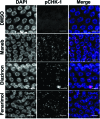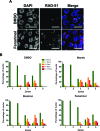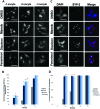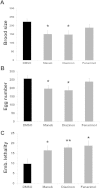Reproductive toxicity and meiotic dysfunction following exposure to the pesticides Maneb, Diazinon and Fenarimol
- PMID: 25984295
- PMCID: PMC4433152
- DOI: 10.1039/C4TX00141A
Reproductive toxicity and meiotic dysfunction following exposure to the pesticides Maneb, Diazinon and Fenarimol
Abstract
The comprehensive identification and mechanistic analysis of reproductive toxicants constitutes one of the major hurdles in the toxicological assessment of chemicals originating from the large number of chemicals to be tested and the difficulty in examining germ cells at various stages of their development. We previously described the development of an assay in the roundworm Caenorhabditis elegans that allows the detection of chemicals bearing aneugenic activity and that could be used for the detection of germline toxicity. We present here new evidence for the reproductive toxicity of three pesticides identified in our germline toxicity assay: Maneb, Diazinon and Fenarimol. We show that all three pesticides cause an acute germline nuclear loss in exposed nematodes in a dose-dependent fashion. The loss of germline nuclei coincides with the meiotic stage of pachytene during Prophase I and is dependent on the germline apoptotic machinery suggesting activation of a meiotic checkpoint. Further investigation revealed a profound dysregulation of the meiotic program revealed by (1) an alteration of the kinetics of double strand repair, (2) the disruption of the process of chromosome morphogenesis at the end of Prophase I and (3) the reorganization of the meiotic differentiation gradient inherent to the C. elegans germline following exposure to Maneb and Diazinon. These defects correlate with a significant increase in embryonic lethality and a corresponding decrease in the number of progeny. These results therefore provide strong evidence for the reproductive toxicity of Maneb, Diazinon and Fenarimol rooted in the alteration of early steps of germ cell differentiation.
Keywords: Caenorhabditis elegans; aneuploidy; chemical screen; reproductive toxicicity.
Figures






Similar articles
-
Comprehensive assessment of germline chemical toxicity using the nematode Caenorhabditis elegans.J Vis Exp. 2015 Feb 22;(96):52445. doi: 10.3791/52445. J Vis Exp. 2015. PMID: 25741987 Free PMC article.
-
Assessing effects of germline exposure to environmental toxicants by high-throughput screening in C. elegans.PLoS Genet. 2019 Feb 14;15(2):e1007975. doi: 10.1371/journal.pgen.1007975. eCollection 2019 Feb. PLoS Genet. 2019. PMID: 30763314 Free PMC article.
-
Environmentally-relevant exposure to diethylhexyl phthalate (DEHP) alters regulation of double-strand break formation and crossover designation leading to germline dysfunction in Caenorhabditis elegans.PLoS Genet. 2020 Jan 9;16(1):e1008529. doi: 10.1371/journal.pgen.1008529. eCollection 2020 Jan. PLoS Genet. 2020. PMID: 31917788 Free PMC article.
-
Latent effects of pesticides and toxic substances on sexual differentiation of rodents.Toxicol Ind Health. 1996 May-Aug;12(3-4):515-31. doi: 10.1177/074823379601200323. Toxicol Ind Health. 1996. PMID: 8843568 Review.
-
Safety and nutritional assessment of GM plants and derived food and feed: the role of animal feeding trials.Food Chem Toxicol. 2008 Mar;46 Suppl 1:S2-70. doi: 10.1016/j.fct.2008.02.008. Epub 2008 Feb 13. Food Chem Toxicol. 2008. PMID: 18328408 Review.
Cited by
-
Models of germ cell development and their application for toxicity studies.Environ Mol Mutagen. 2015 Oct;56(8):637-49. doi: 10.1002/em.21946. Epub 2015 Mar 28. Environ Mol Mutagen. 2015. PMID: 25821157 Free PMC article. Review.
-
Effects of sub-lethal teratogen exposure during larval development on egg laying and egg quality in adult Caenorhabditis elegans.F1000Res. 2016 Dec 28;5:2925. doi: 10.12688/f1000research.8934.1. eCollection 2016. F1000Res. 2016. PMID: 28163903 Free PMC article.
-
ace-3 plays an important role in phoxim resistance in Caenorhabditis elegans.Ecotoxicology. 2016 May;25(4):835-44. doi: 10.1007/s10646-016-1640-z. Epub 2016 Mar 7. Ecotoxicology. 2016. PMID: 26947509
-
Antioxidant CoQ10 Restores Fertility by Rescuing Bisphenol A-Induced Oxidative DNA Damage in the Caenorhabditis elegans Germline.Genetics. 2020 Feb;214(2):381-395. doi: 10.1534/genetics.119.302939. Epub 2019 Dec 18. Genetics. 2020. PMID: 31852725 Free PMC article.
-
Screening and characterization of 133 physiologically-relevant environmental chemicals for reproductive toxicity.Reprod Toxicol. 2024 Jun;126:108602. doi: 10.1016/j.reprotox.2024.108602. Epub 2024 May 8. Reprod Toxicol. 2024. PMID: 38723698 Free PMC article.
References
Grants and funding
LinkOut - more resources
Full Text Sources
Other Literature Sources

